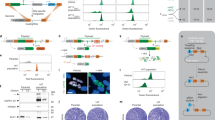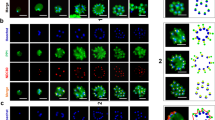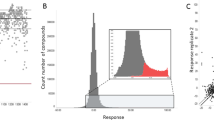Abstract
Calcium-dependent protein kinases play a crucial role in intracellular calcium signaling in plants, some algae and protozoa. In Plasmodium falciparum, calcium-dependent protein kinase 1 (PfCDPK1) is expressed during schizogony in the erythrocytic stage as well as in the sporozoite stage. It is coexpressed with genes that encode the parasite motor complex, a cellular component required for parasite invasion of host cells, parasite motility and potentially cytokinesis. A targeted gene-disruption approach demonstrated that pfcdpk1 seems to be essential for parasite viability. An in vitro biochemical screen using recombinant PfCDPK1 against a library of 20,000 compounds resulted in the identification of a series of structurally related 2,6,9-trisubstituted purines. Compound treatment caused sudden developmental arrest at the late schizont stage in P. falciparum and a large reduction in intracellular parasites in Toxoplasma gondii, which suggests a possible role for PfCDPK1 in regulation of parasite motility during egress and invasion.
This is a preview of subscription content, access via your institution
Access options
Subscribe to this journal
Receive 12 print issues and online access
$259.00 per year
only $21.58 per issue
Buy this article
- Purchase on Springer Link
- Instant access to full article PDF
Prices may be subject to local taxes which are calculated during checkout





Similar content being viewed by others
References
Snow, R.W., Guerra, C.A., Noor, A.M., Myint, H.Y. & Hay, S.I. The global distribution of clinical episodes of Plasmodium falciparum malaria. Nature 434, 214–217 (2005).
Garcia, C.R. Calcium homeostasis and signaling in the blood-stage malaria parasite. Parasitol. Today 15, 488–491 (1999).
Gazarini, M.L., Thomas, A.P., Pozzan, T. & Garcia, C.R. Calcium signaling in a low calcium environment: how the intracellular malaria parasite solves the problem. J. Cell Biol. 161, 103–110 (2003).
Nagamune, K. & Sibley, L.D. Comparative genomic and phylogenetic analyses of calcium ATPases and calcium-regulated proteins in the apicomplexa. Mol. Biol. Evol. 23, 1613–1627 (2006).
Ward, P., Equinet, L., Packer, J. & Doerig, C. Protein kinases of the human malaria parasite Plasmodium falciparum: the kinome of a divergent eukaryote. BMC Genomics 5, 79 (2004).
Billker, O. et al. Calcium and a calcium-dependent protein kinase regulate gamete formation and mosquito transmission in a malaria parasite. Cell 117, 503–514 (2004).
Ishino, T., Orito, Y., Chinzei, Y. & Yuda, M. A calcium-dependent protein kinase regulates Plasmodium ookinete access to the midgut epithelial cell. Mol. Microbiol. 59, 1175–1184 (2006).
Siden-Kiamos, I. et al. Plasmodium berghei calcium-dependent protein kinase 3 is required for ookinete gliding motility and mosquito midgut invasion. Mol. Microbiol. 60, 1355–1363 (2006).
Le Roch, K.G. et al. Discovery of gene function by expression profiling of the malaria parasite life cycle. Science 301, 1503–1508 (2003).
Moskes, C. et al. Export of Plasmodium falciparum calcium-dependent protein kinase 1 to the parasitophorous vacuole is dependent on three N-terminal membrane anchor motifs. Mol. Microbiol. 54, 676–691 (2004).
Sanders, P.R. et al. Distinct protein classes including novel merozoite surface antigens in Raft-like membranes of Plasmodium falciparum. J. Biol. Chem. 280, 40169–40176 (2005).
Young, J.A. et al. The Plasmodium falciparum sexual development transcriptome: a microarray analysis using ontology-based pattern identification. Mol. Biochem. Parasitol. 143, 67–79 (2005).
Zhou, Y. et al. Evidence-based annotation of the malaria parasite's genome using comparative expression profiling. PLoS ONE 3, e1570 (2008).
Baum, J. et al. A conserved molecular motor drives cell invasion and gliding motility across malaria life cycle stages and other apicomplexan parasites. J. Biol. Chem. 281, 5197–5208 (2006).
Heintzelman, M.B. Cellular and molecular mechanics of gliding locomotion in eukaryotes. Int. Rev. Cytol. 251, 79–129 (2006).
Lovett, J.L. & Sibley, L.D. Intracellular calcium stores in Toxoplasma gondii govern invasion of host cells. J. Cell Sci. 116, 3009–3016 (2003).
Bergman, L.W. et al. Myosin A tail domain interacting protein (MTIP) localizes to the inner membrane complex of Plasmodium sporozoites. J. Cell Sci. 116, 39–49 (2003).
Green, J.L. et al. The MTIP-myosin A complex in blood stage malaria parasites. J. Mol. Biol. 355, 933–941 (2006).
Meissner, M., Schluter, D. & Soldati, D. Role of Toxoplasma gondii myosin A in powering parasite gliding and host cell invasion. Science 298, 837–840 (2002).
Carruthers, V.B. & Sibley, L.D. Mobilization of intracellular calcium stimulates microneme discharge in Toxoplasma gondii. Mol. Microbiol. 31, 421–428 (1999).
Duraisingh, M.T., Triglia, T. & Cowman, A.F. Negative selection of Plasmodium falciparum reveals targeted gene deletion by double crossover recombination. Int. J. Parasitol. 32, 81–89 (2002).
Zhang, J.H., Chung, T.D. & Oldenburg, K.R. A simple statistical parameter for use in evaluation and validation of high throughput screening assays. J. Biomol. Screen. 4, 67–73 (1999).
Ding, S., Gray, N.S., Wu, X., Ding, Q. & Schultz, P.G. A combinatorial scaffold approach toward kinase-directed heterocycle libraries. J. Am. Chem. Soc. 124, 1594–1596 (2002).
Bennett, T.N. et al. Novel, rapid, and inexpensive cell-based quantification of antimalarial drug efficacy. Antimicrob. Agents Chemother. 48, 1807–1810 (2004).
Smilkstein, M., Sriwilaijaroen, N., Kelly, J.X., Wilairat, P. & Riscoe, M. Simple and inexpensive fluorescence-based technique for high-throughput antimalarial drug screening. Antimicrob. Agents Chemother. 48, 1803–1806 (2004).
Chulay, J.D., Haynes, J.D. & Diggs, C.L. Plasmodium falciparum: assessment of in vitro growth by [3H]hypoxanthine incorporation. Exp. Parasitol. 55, 138–146 (1983).
Duraisingh, M.T. et al. Linkage disequilibrium between two chromosomally distinct loci associated with increased resistance to chloroquine in Plasmodium falciparum. Parasitology 121, 1–7 (2000).
Fotie, J. et al. Lupeol long-chain fatty acid esters with antimalarial activity from Holarrhena floribunda. J. Nat. Prod. 69, 62–67 (2006).
Florens, L. et al. A proteomic view of the Plasmodium falciparum life cycle. Nature 419, 520–526 (2002).
Baldwin, J. et al. High-throughput screening for potent and selective inhibitors of Plasmodium falciparum dihydroorotate dehydrogenase. J. Biol. Chem. 280, 21847–21853 (2005).
Barrera, L., Benner, C., Tao, Y.C., Winzeler, E. & Zhou, Y. Leveraging two-way probe-level block design for identifying differential gene expression with high-density oligonucleotide arrays. BMC Bioinformatics 5, 42 (2004).
Oshiro, G. et al. Parallel identification of new genes in Saccharomyces cerevisiae. Genome Res. 12, 1210–1220 (2002).
Ashburner, M. et al. Gene ontology: tool for the unification of biology. The Gene Ontology Consortium. Nat. Genet. 25, 25–29 (2000).
Suthram, S., Sittler, T. & Ideker, T. The Plasmodium protein network diverges from those of other eukaryotes. Nature 438, 108–112 (2005).
Bosch, J. et al. The closed MTIP-myosin A-tail complex from the malaria parasite invasion machinery. J. Mol. Biol. 372, 77–88 (2007).
Kidgell, C. et al. A systematic map of genetic variation in Plasmodium falciparum. PLoS Pathog. 2, e57 (2006).
Peters, W. & Robinson, B.L. in Handbook of Animal Models of Infection (eds. Zak, O. & Sande, M.) 757–773 (Academic, London, 1999).
Srinivasan, A.N. & Krupa, A. A genomic perspective of protein kinases in Plasmodium falciparum. Proteins 58, 180–189 (2005).
Wetzel, D.M., Chen, L.A., Ruiz, F.A., Moreno, S.N. & Sibley, L.D. Calcium-mediated protein secretion potentiates motility in Toxoplasma gondii. J. Cell Sci. 117, 5739–5748 (2004).
Keeley, A. & Soldati, D. The glideosome: a molecular machine powering motility and host-cell invasion by Apicomplexa. Trends Cell Biol. 14, 528–532 (2004).
Gantt, S. et al. Antibodies against thrombospondin-related anonymous protein do not inhibit Plasmodium sporozoite infectivity in vivo. Infect. Immun. 68, 3667–3673 (2000).
Kieschnick, H., Wakefield, T., Narducci, C.A. & Beckers, C. Toxoplasma gondii attachment to host cells is regulated by a calmodulin-like domain protein kinase. J. Biol. Chem. 276, 12369–12377 (2001).
Karcher, R.L. et al. Cell cycle regulation of myosin-V by calcium/calmodulin-dependent protein kinase II. Science 293, 1317–1320 (2001).
Kugelstadt, D., Winter, D., Pluckhahn, K., Lehmann, W.D. & Kappes, B. Raf kinase inhibitor protein affects activity of Plasmodium falciparum calcium-dependent protein kinase 1. Mol. Biochem. Parasitol. 151, 111–117 (2007).
LaCount, D.J. et al. A protein interaction network of the malaria parasite Plasmodium falciparum. Nature 438, 103–107 (2005).
Cardone, M.H. et al. Regulation of cell death protease caspase-9 by phosphorylation. Science 282, 1318–1321 (1998).
Arastu-Kapur, S. et al. Identification of proteases that regulate erythrocyte rupture by the malaria parasite Plasmodium falciparum. Nat. Chem. Biol. 4, 203–213 (2008).
Yeoh, S. et al. Subcellular discharge of a serine protease mediates release of invasive malaria parasites from host erythrocytes. Cell 131, 1072–1083 (2007).
Lambros, C. & Vanderberg, J.P. Synchronization of Plasmodium falciparum erythrocytic stages in culture. J. Parasitol. 65, 418–420 (1979).
Carey, K.L., Westwood, N.J., Mitchison, T.J. & Ward, G.E. A small-molecule approach to studying invasive mechanisms of Toxoplasma gondii. Proc. Natl. Acad. Sci. USA 101, 7433–7438 (2004).
Acknowledgements
We thank V. Nussenzweig (New York University) for providing oocyst and sporozoite stages of P. yoelii and A. Godfrey-Certner for her assistance with the T. gondii invasion assays. This work was supported by a grant to E.A.W. from the Ellison Foundation, the Keck Foundation and the US National Institutes of Health (AI059472-02), a grant to G.E.W. from the US National Institutes of Health (AI054961), and grants to the Genomics Institute of the Novartis Research Foundation from the Wellcome Trust and the Medicines for Malaria Venture.
Author information
Authors and Affiliations
Corresponding author
Supplementary information
Supplementary Text and Figures
Supplementary Figures 1–8, Supplementary Tables 1 and 2, and Supplementary Methods (PDF 3468 kb)
Rights and permissions
About this article
Cite this article
Kato, N., Sakata, T., Breton, G. et al. Gene expression signatures and small-molecule compounds link a protein kinase to Plasmodium falciparum motility. Nat Chem Biol 4, 347–356 (2008). https://doi.org/10.1038/nchembio.87
Received:
Accepted:
Published:
Issue Date:
DOI: https://doi.org/10.1038/nchembio.87
This article is cited by
-
Screening the Toxoplasma kinome with high-throughput tagging identifies a regulator of invasion and egress
Nature Microbiology (2022)
-
Ned-19 inhibition of parasite growth and multiplication suggests a role for NAADP mediated signalling in the asexual development of Plasmodium falciparum
Malaria Journal (2017)
-
PfCDPK1 mediated signaling in erythrocytic stages of Plasmodium falciparum
Nature Communications (2017)
-
An essential malaria protein defines the architecture of blood-stage and transmission-stage parasites
Nature Communications (2016)
-
Phosphoproteomics reveals malaria parasite Protein Kinase G as a signalling hub regulating egress and invasion
Nature Communications (2015)



